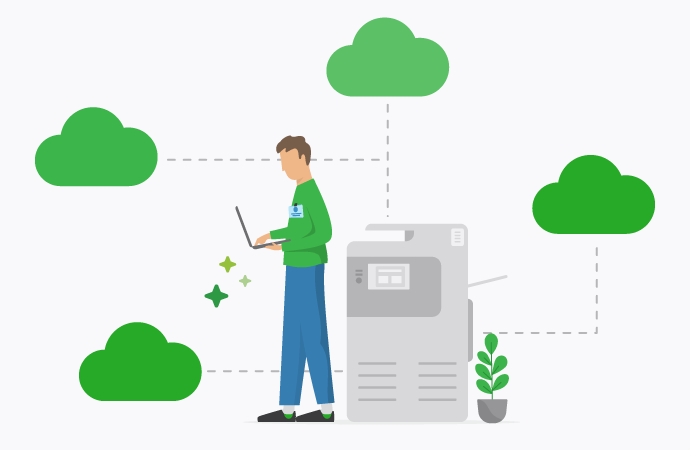Cloud printing has been a gamechanger for organizational efficiency – combining the power of the cloud with the convenience of quick and easy printing. But the adoption of multiple cloud providers means that many businesses now need to figure out how to make different cloud systems “talk” to each other.
Enter multi cloud networking: the veritable Babel fish if you will. It’s a new technology that provides easy connectivity between all your cloud environments.
Overview of multi cloud networking
These days, most businesses are using a number of public and private cloud platforms from different vendors to manage different business functions such as printing. However, these are often brought in ad hoc and aren’t necessarily able to connect with each other. The result is a messy multi cloud environment with unintended data silos within different cloud providers – leading to a whole bunch of integration problems.
Multi-cloud networking (MCN) provides connectivity between services across multiple public and private clouds, data centers, and Software as a Service (SaaS) providers. MCN technology is a single architecture that sits above an organization’s cloud platforms to facilitate the transfer of data between them – delivering centralized control for IT admins, better network performance, and a consistent, seamless experience for the end user.
Solving the challenge of multi cloud integration
When it comes to integrating multiple cloud platforms, organizations face a number of challenges including monitoring, administration, security, and management of resources and workloads. The bottom line is, the more cloud providers you use, the more complex it becomes to integrate your cloud environment.
Different vendors have their own unique features and tools, and many IT teams lack the time and expertise to manage each application separately and manually. Without keeping track of what’s happening in every environment, an organization can end up with security vulnerabilities, costly mistakes, and impacts to their overall efficiency.
The solution is multi-cloud networking (MCN) technology, which gives you real-time visibility and control across all your cloud environments from a single interface. By simplifying and consolidating integration into one comprehensive multi cloud platform, your IT team is able to focus on their day-to-day without having to build up specialized cloud skills.
Security considerations in a multi cloud setup
Many organizations are understandably concerned about managing security across a multi cloud environment. With each new platform added, more time and effort are involved with protecting data and preventing a breach or leak.[NA2]
MCN can help enhance security by integrating third-party security features and policies across all your cloud services to provide greater protection and resilience for the entire multi cloud environment. This enables you to move workloads and data between cloud providers securely and easily.
Multi cloud security architecture generally includes:
- Centralized management, including dashboards and automated reporting and logging.
- Identity and access management to control user access to cloud resources.
- Data encryption to protect data both in transit and in storage.
- Secure network connections and protocols across different cloud providers.
- Advanced security features such as firewalls and Zero Trust Network Access (ZTNA).
- API management to secure apps and APIs across all cloud services.
- Threat detection and response, as well as backup and data recovery plans.
Benefits of multi cloud environments
MCN technology enables you to harness the power of multiple cloud providers for print services and all other applications. Benefits include:
- Flexibility. Rather than being locked in with a single vendor, you get to choose the most appropriate cloud provider for each application and service.
- Cost efficiency. You can take advantage of the best pricing and performance across different providers, to optimize your spending on cloud services.
- New technologies. With cloud providers constantly developing new products, you’re able to easily switch to a different provider and leverage the latest technological innovations.
- Reduced downtime. Multi cloud reduces the risk of a single point of failure, as an outage in one cloud provider won’t impact services in other clouds.
- Better data security. With multiple cloud providers, your data is stored in different locations with limited access for each vendor.
Optimizing costs with multi cloud strategies
To maximize the value of a multi cloud environment, you need to look at how to optimize costs – so you can make appropriate spending decisions. The first step is to set clear budgets, with cloud costs allocated to different departments, teams and projects based on their expected workloads. This enables cloud admins to track where and how much money is being spent.
Best practice is to regularly analyze usage and audit the related cloud costs to ensure your cloud strategy adapts to any fluctuations in demand for different services. Your workplace can significantly cut back their cloud expenses simply by shutting down unused resources.
A cloud cost management platform can consolidate data from various cloud providers and deliver customized, automated reports – to help you accurately forecast cloud spending and allocate resources appropriately.


